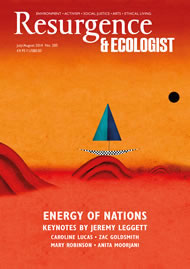The philosophy of the internationally renowned artist El Anatsui (born in Ghana in 1944) is “You do art with whatever is around you.” He describes his vibrant creations as being “disfigured in an organic way”. “Cocooned in the quiet [Nigerian] village of Nsukka”, aided by three dozen diligent studio assistants, he weaves monumental, diaphanous metal wall sculptures out of a mass of gritty detritus. He collects countless aluminium alcohol bottle tops, which are then variously hammered, crimped and stitched together into immense sheet-like assemblages composed of multitudinous shimmering tesserae. Other materials he uses include caches of jagged can lids, discarded cassava graters and tiny lattice-patterned roofing strips, all laboriously sewn together with copper wire.
As a boy, El Anatsui observed his father and brothers working as textile weavers. He absorbed something of their skilful approach, and, deciding early on he wanted to be an artist, at the age of 20 he left home to study art in Ghana; in 1975 he took up a teaching post at the university in Nsukka. His early work included deliberately fractured ceramic pots and wooden wall reliefs, their sinuous lines charred with a blowtorch.
Susan Mullin Vogel’s gorgeously illustrated, discerningly written book quotes liberally from the artist himself. A chance discovery one day in 1998 was key: “I came upon ... this curious bag in the bushes... Several things went through my mind when I found the bag of bottle tops... I thought of the objects as links between my continent, Africa, and the rest of Europe. Objects such as these were introduced to Africa by Europeans when they came as traders. Alcohol was one of the commodities brought with them to exchange for goods in Africa. Eventually alcohol became one of the items used in the transatlantic slave trade. They made rum in the West Indies, took it to Liverpool, and then it made its way back to Africa. I thought that the bottle caps had a strong reference to the history of Africa.”
He kept the bottle tops in his studio for several months, and then had the idea of stitching them together. “I discovered that the result resembled a real fabric cloth. Incidentally too, the colours of the caps seemed to replicate those for traditional [West African] kente cloths.” The deep historical resonances of such ordinarily abandoned items as a simple bottle top imbue his abstracted works with poignant fresh meanings and associations. His materials “are sourced from my immediate environment, they have been put to intense human use. They are thought to have lost value. They are ignored, discarded or thrown away. They all have something to do with food consumption... I … try to bring these objects back, to present them again in new ways which seem to make them confront their former lives and the lives of those who have used them.” He says he is happy not to come from an industrial society, and he relishes the way that everything people do in the local market – peeling oranges, for instance – is achieved with elegant artistry.
El Anatsui regularly visits the bustling recycling markets just outside Nsukka, where he buys big burlap bags full of milk-tin lids, which a stallholder swiftly detaches from cans with a knife. He acquires bags of bottle caps from local distilleries: returned bottles can be reused, but their non-reusable tops are sold on as scrap aluminium.
He says: “I don’t see what I do as recycling: I transform the caps into something else.” His suspended metallic simulacra of textiles become kinetic artefacts of incredible sensuous intricacy and contemplative power. At their heart is the curious paradox that ephemeral materials from lives of often grinding poverty, generations of loss, forced migration and displacement are transformed into works of transcendental opulence. El Anatsui has developed what he calls “a kind of nomadic mentality”, which he sees as his saving grace as both a man and an artist. Now celebrated by the art world, he remains detached from the wider art world’s stifling expectations yet stays true to both his own searchingly original avant-gardism and the nature of his daily surroundings. He tells the story of a leading New York gallery owner who had been expecting a shipment of works for an imminent exhibition, and to his dismay and surprise, “found the artist alone on the gallery doorstep with two suitcases. Of course the whole exhibition was in them, neatly folded.”







